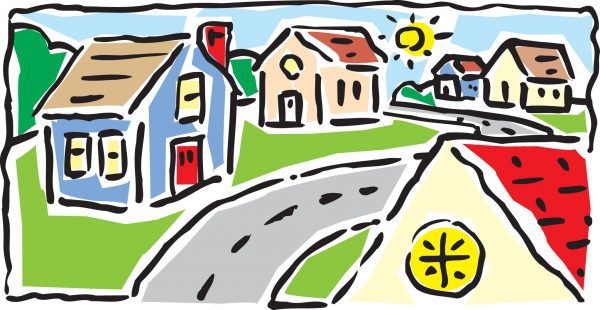 Gil Rendle raises a number of questions for congregations to consider in his book Quietly Courageous. The first three on a list on page 249 strike me as critical for a church that wants to do more than just survive: Who are we now? Who is my neighbor now? What does God call us to do now? You’ll notice each question ends with the word “now.”
Gil Rendle raises a number of questions for congregations to consider in his book Quietly Courageous. The first three on a list on page 249 strike me as critical for a church that wants to do more than just survive: Who are we now? Who is my neighbor now? What does God call us to do now? You’ll notice each question ends with the word “now.”
Churches can often describe who they were, who they used to be. If the congregation was started during the post-World War II boom, there might still be some charter members who can describe the motivation behind the choice for the church’s location and the groups who were intended as the original target audience for that congregation. Members who were around during the 50s and 60s can remember bulging sanctuaries, overflowing Sunday School classrooms, and mammoth youth groups. Those may be fond memories, but as the saying goes, “That was then. This is now.”
Who are we now? We probably serve an older demographic. Our congregation members may well have a higher educational level than the population in the surrounding area. Maybe we’re not as reflective of the community as we used to be. Back in the day, members may have known the names of every family in a three or four block radius surrounding the church as well as what church each family went to; now, members may not even know the names of every family on the same block as the church. Back then, people tended to know everybody because almost every member lived in that neighborhood. Their kids went to school together and played sports together. In an era before air conditioning, cable TV, video games, social media, and cell phones, people spent more time outside, especially in the summer, talking with and getting to know their neighbors. Nowadays, that’s not the case – a reality that’s compounded by the fact that most church members probably no longer live in the same neighborhood as the church, even if they did grow up there. Now, they may drive to the church for worship or for a midweek meeting, and they may not notice much of anything except for how the homes look smaller than they remember or how the trees have all been cut down and the vacant lots have disappeared.
When my daughter was watching “Sesame Street” when she was growing up, they would occasionally include the song “Who are the People in Your Neighborhood?” The answer to that question was “They’re the people that you meet when you’re walking down the street. They’re the people that you meet each day.” If you’re not there every day and you’re not walking down the street, you won’t meet and you won’t get to know your neighbors. Actually, walking the streets around the church may well be a good way to get to know your neighbors. As you do so, notice the people, the homes, and the cars. You might also talk to the principals of the local elementary, middle, and high school about what they know about the demographics of the families they serve and what they see as the biggest problems facing their students.
The PCUSA offers some help with demographics too. There, you can find
- Church Trends in Your Congregation: A statistical summary based on the Session Annual Statistical Reports submitted to the Office of the General Assembly
- Demographic Report: This will help you learn about the people who live in the community around your church. The Demographic Report can help your congregation identify mission and outreach possibilities.
- Congregational Surveys: A survey can give your congregation a picture of who worships there (including age and marital status of members, average length of church membership, etc.), information about the strengths and priorities of church programs, and tools for strategic planning. Use a congregational survey to identify and build on your congregation’s unique strengths.
- Research Strategies for Congregations: A packet of easy information gathering tools designed to help you learn more about your worshipers and your local community
- RCMS data (Religious Congregations & Membership Study): Details about the number and types of congregations and their members in every state, county, and metro area in the United States. Learn more about the religious landscape where your church is located.
The last question may well be the most difficult one to answer. It takes work, but you can figure out the demographics, as well as the needs, of your members and your community. Discerning what God is calling us to do now, however, seems like a far more subjective question. If we are to love our neighbors as we love ourselves (Mark 12:31), the answer would depend on who our neighbors are now. So maybe we need to get to know them and maybe then we could ask them. Sometimes, though, it seems that churches take on an almost “vampire” mentality; to outsiders, it may appear that Christians don’t really care about them, that they just want their time, their money, and their energy so that their church can survive. People sense that and may not be open or honest in what they tell us. Who we are now may also limit – or we think it may limit – what we are able – or perhaps willing – to do now.
 Maybe one way we can begin to get at the question “What is God calling us to do now?” is to ask another question: “Where have you seen God at work in our neighborhood or in our community?” You could make that a part of the opening of every session and/or deacons meeting. You might also tweak that and make it a little more personal by asking, “Where have you seen God at work in your life?” or perhaps “Where have you seen God at work this past week?”
Maybe one way we can begin to get at the question “What is God calling us to do now?” is to ask another question: “Where have you seen God at work in our neighborhood or in our community?” You could make that a part of the opening of every session and/or deacons meeting. You might also tweak that and make it a little more personal by asking, “Where have you seen God at work in your life?” or perhaps “Where have you seen God at work this past week?”
Once we’re able to identify and articulate where we see God at work, then we can find ways to build on that or join with other churches or organizations that have found a way to be actively involved in people’s lives. God is already at work in our communities. God has not abandoned us. I think God would be proud that we’re willing to look at ourselves, as well as our neighbors, with new eyes and that we’re willing to do some things that show we’re taking our faith and taking our God seriously. That starts by asking some questions now.
